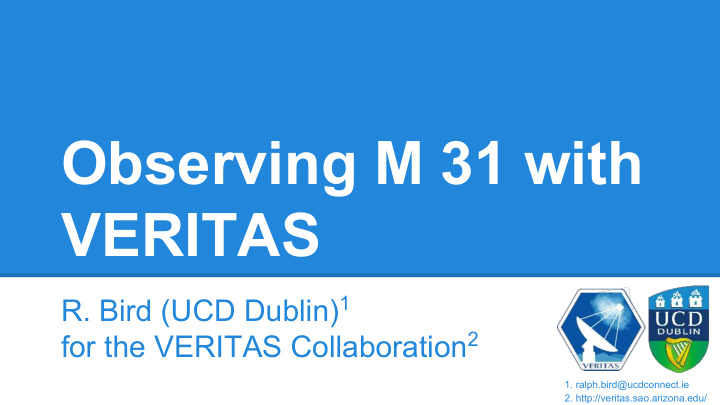



Observing M 31 with VERITAS R. Bird (UCD Dublin) 1 for the VERITAS Collaboration 2 1. ralph.bird@ucdconnect.ie 2. http://veritas.sao.arizona.edu/
M 31 - a well-studied object ISM rich Star Forming Ring
A testbed for diffuse VHE gamma-ray emission IRIS 100 um (far IR) Emission is predicted to occur in gas Red circles are SNRs in rich regions due to interaction of CRs M31DEEPXMM with the ISM (primarily HI). Majority of the gas and SNRs contained in a star forming ring ~ 10 kpc from the galaxy core. PSF
and a potential dark matter candidate R (kpc) Tam, A. et al, A&A, 546, A4, (2012)
Updated Fermi -LAT extended source analysis Update of published result using a model map from the IRIS 100 um 2FGL sources & 1ES 0037 + 405 from the 1FHL & a point source at (00 48 18.0, 39 3 28.49) Resultant fit for M 31 TS = 84.65 > 100 MeV integral flux = (1.06 ± 0.25) x 10 -8 ph cm -2 s -1 gamma = 2.31 ± 0.08 Whole source! Extrapolate for > 300 GeV integral flux - it is fairly weak unless (3.50 ± 2.35) x 10 -13 ph cm -2 s -1 (0.3 ± 0.2% Crab) something else is contributing at higher energies
VERITAS Array of four 12-m diameter Cherenkov telescopes F.L.Whipple Observatory, Mt Hopkins, AZ Energy range: 85 GeV - 30 TeV Energy resolution: 15% - 25% Angular resolution: 0.1 o See talk by N. Otte tomorrow
VERITAS Observations Legacy Dataset ● 13.4 hours targeted on M 31 (pre camera upgrade, post T1 move) ● 15.6 hours targeted on other sources but covering M 31 (all 4 telescope array configurations) Never fully analysed due to challenges with optical brightness and size. Not detected at VHE, HEGRA collaboration upper limits (point sources, > 500 GeV, 20.1 hours) ● central region < 3% Crab ● edges < 30% Crab
The Challenge It is big ... Approximate VERITAS FOV
The Challenge ... and optically bright
The impact on data Optically bright > high currents > higher cleaning threshold > central hole Large central hole IRIS 100 um contours excess negative significance
Possible approaches Extend central exclusion region - Excludes the source we want to measure Increase the size cut - Needs to be very high to reduce hole sufficiently Single image cleaning thresholds across the camera - Approach used in this analysis - Thresholds fixed to a compromise between affected and “background” pixels Additional image cleaning parameters - To be examined in future work
Fixed Threshold Cleaning The solution? - improvements but not perfect Central hole smaller no negative significance excess
Impact on sensitivity 200 minutes of Crab Data Standard Threshold E thresh = 120 GeV E thresh = 130 GeV Scaled to 1% Crab, sigma/sqrt hr = 0.539 Scaled to 1% Crab, sigma/sqrt hr = 0.511
Preliminary point-source upper limits Galaxy core excluded due to optical brightness. Preliminary, simple approach. 1 Use two regions (purple). 2 UL’s (99%, Rolke) for M 31 targetted data only Integral flux > 300 GeV 1: 6.2x10 -12 ph cm -2 s -1 (5.3% Crab) 2: 6.9x10 -12 ph cm -2 s -1 (5.9% Crab)
Comparison with model Several diffuse gamma ray emission models exist, e.g. Aharonian & Atoyan (2000), and Kelner, Aharonian and Bugayov (2008). Can use detailed HI map (eg [1]) and Predicted > 300 GeV flux compare with gamma ray observations to test models. BUT need sufficiently detailed VHE observations. Total predicted flux (> 300 GeV) Tiny, but very much = 7.7 x 10 -14 ph cm -2 s -1 a lower limit ~= 0.05% Crab [1] Braun, R., et al., ApJ, 695,2,937-953 (2009).
Predicted fluxes The measured flux from diffuse emission is expected to scale as (1/distance) 2 x M hydrogen x Star Formation Rate Distance Galaxy (Mass Hydrogen) Galaxy / Threshold / Predicted Flux / SFR Galaxy / Prediction % Crab 10 -13 ph cm -2 s -1 / Distance M31 SFR M31 (Mass Hydrogen) M3 GeV Extrapolated Fermi-LAT 300 3.50 ± 2.3 0.3 Result Theoretical 300 0.77 0.05 Model M 82 Scaled 4.65 30.8 0.18 700 14.5 3.5 NGC 253 5.05 10.8 1.35 250 9.78 0.37 Scaled
Conclusions Predicted VHE flux 0.05 - 3.5% Crab, observations have potential to provide useful insights into the origin of diffuse gamma rays VHE observations challenging due to size and optical brightness Fixing cleaning thresholds reduces impact of optical brightness for small loss of sensitivity and increase in energy threshold Preliminary point-source upper limits from a subset of the data < 5.9% Crab Analysis of additional data, an extended-source analysis and an improved upper-limit calculation are ongoing
This presentation was produced as part of the output of the DGGP, funded under the Programme for Research in Third Level Institutions (PRTLI) Cycle 5 and co-funded by the European Regional Development Fund.
Backup Slides
Fermi-LAT sky maps Residuals Map Residuals Map (counts) (significance) Counts Map Model Map
Recommend
More recommend